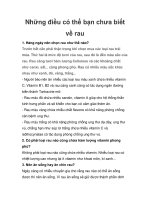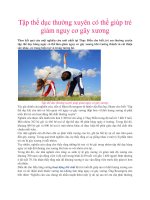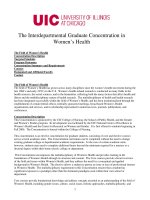The Best Exercises You''''ve Never Heard Of potx
Bạn đang xem bản rút gọn của tài liệu. Xem và tải ngay bản đầy đủ của tài liệu tại đây (613.35 KB, 71 trang )
Sign up for BetterU News!
Get powerful, innovative health, fitness, fat loss and training information
delivered straight to your mailbox FREE!
Send an email to with the word "subscribe" in the
subject line.
Now You've Done It!
You've unleashed an avalanche of incredible information that will help
you get results beyond what you ever thought possible!
Introduction:
In this sample book you will find five fantastic exercises for several of the
major muscle groups in your body. Remember, this is only a very small
taste of the innovative exercises found in "The Best Exercises You've
Never Heard Of!"
You can read more about what "The Best Exercises" can do for you by
clicking here.
How To Do It:
Read through the exercise descriptions thoroughly so you know exactly
what the exercise is going to accomplish, how to execute it properly and
safely and how to best incorporate the exercise into your workouts.
Common Errors:
The "Common Errors" section of each exercise will let you know some of
the typical ways the exercise is done improperly so you can take steps to
correct yourself before they even happen!
Tricks:
Finally, be sure to read through all the "Tricks" for each exercise. There are
tips that will help you get even more out of these already amazing
exercises.
I Want Your Feedback!
I welcome your comments and questions! Please do not hesitate to contact
me via email at or by using the Contact Us page.
Let me know what you liked or didn't like about this book. I want to know
how I can make it better to better serve your needs.
Nick Nilsson
Vice-President
BetterU, Inc.
/> />
When you see this graphic:
That means the exercise has
a video demonstration!
Note: if you have trouble viewing the
videos, you may need to update your
Windows Media Player
Please Note:
Any exercise program contains an element of risk. Be aware that the exercises in the book are not familiar to you and, even
though every attempt has been made to ensure safe instruction, how and if you decide to execute the exercises is ultimately your
responsibility.
By reading the information in this book you hereby agree to the Terms and Conditions of use.
Your Five Free Exercises:
Exercise #2
Exercise #1
Nilsson Curls
Exercise #3
Bench End Dumbell Presses
Exercise #4
Rear Delt Rope Pullbacks
Full Range Pulldowns
Exercise #5
Bodyweight Tricep
Extensions
Plus! Click here to learn how you can get a sixth exercise absolutely free!
Click Here to read more about what "The Best Exercises" can do for you!
Note: The information found in this program does not constitute medical advice and should not be taken as such. Consult your
physician before taking part in any exercise program.
Note: you will also receive a complimentary subscription to my entertaining and informative fitness
and exercise newsletter BetterU News when you sign up for the free exercise.
Copyright 2006 BetterU, Inc. ©
Other Recommended Links
Contact Us
Sign up for BetterU News!
Get powerful, innovative health, fitness, fat
loss and training information delivered
straight to your mailbox FREE!
Send an email to
with the word "subscribe" in the subject
line.
Nilsson Curls
Forearm-Braced Chin-Ups
Why Is This Exercise So Effective?
The Nilsson Curl, which can technically be described as a
forearm-braced chin-up movement, is a unique biceps exercise.
The reason: it uses your total bodyweight for resistance!
Most biceps exercises, such as barbell and dumbell curls, require
that you move the resistance around your body while your body
remains anchored.
While this is certainly effective, it has been established that
exercises which require you to move your body around a fixed
object (such as occurs during a chin-up) fire many more muscle
fibers. This results in a much more effective exercise for the
muscle!
And if that wasn't enough to make this a killer exercise, have a
look at this:
The majority of biceps exercises are isolation exercises. They
work the biceps across only one joint (the elbow). This seriously
limits the amount of weight you can use and hence limits your
ultimate biceps development.
The Nilsson Curl is a compound exercise for the biceps that
uses the lats only as secondary movers to assist your biceps
during the exercise. Working the biceps at two joints rather than
just one (such as in this chin-up movement), drastically
increasing the amount of weight you can use on a biceps
exercise.
Now throw almost all of the resistance of the chin-up (your entire
bodyweight) onto the biceps and you'll know the meaning of the
word "pump!"
Combine these three features (moving your body around a fixed
object for more muscle activation, using a two-joint movement,
and having your entire bodyweight as resistance) into a biceps
exercise and you have yourself one incredibly powerful
movement!
This exercise is best done using the safety
rails of a power rack. There are other
methods of setting up that you can use that
are just as effective. I will detail these at
the end of this section.
q
q
q
q
q
The absolute easiest way is to use
the two, bottom safety rails of the
rack.
They need to be the type that you
can slide completely out of the rack
for this method to work, as you'll be
placing them on the same side of
the rack uprights.
Place one of the rails in the highest
set of holes in the rack.
Set the other rail in the set of holes
approximately one foot down from
that top one in the same side
uprights.
Your setup will look like two rungs
in a ladder.
Now you're all set!
q
Grip the top bar and brace your
forearm against the bottom bar (you
may want to use a pad or a towel
wrapped around the bottom bar for
your forearms).
q
Keeping your forearms pressed
against the bottom bar throughout
the entire exercise, curl yourself up.
q
q
This is the most important point to
remember about this exercise, as
bracing your forearms is what
sends all the tension to your biceps.
It does this by reducing the
involvement of the lats.
Also, try to keep your shoulders
back in a neutral position. Don't
allow them to hunch forward during
the exercise. This keeps them in a
more stable position.
Squeeze hard at the top. This
instruction is kind of unnecessary to
be honest. You won't really have a
choice at that point - the tension on
your biceps is just incredible!
How to incorporate this exercise into your workouts:
This exercise should be the first biceps exercise you do in your workout.
q
It requires tremendous strength and therefore is best done with fresh biceps.
1. Pulling Straight Up
For best results, pull yourself up in an arc. This will most strongly affect the biceps. Pulling
straight up will still work, just not quite as strongly.
2. Using Momentum
Always do this exercise deliberately and under control to maintain maximum tension on the
biceps. Moving quickly will only decrease the effectiveness of the exercise.
It is especially important not to use momentum as you come to the bottom of the exercise as your
elbows are braced against a rail. You could injure your elbows if you slam down into the bottom
of the rep.
3. Hunching the Shoulders Forward
Try to keep your shoulders back and in a neutral position. Do not allow them to hunch forward.
This will help to maintain a more stable position for the shoulder joint.
1. Using Barbells To Set Up
If you don't have access to a rack that uses the removable bottom safety rails you can also use
two barbells inside the rack.
q
q
q
q
q
Start by setting the racking hooks in the highest holes.
Set an Olympic bar in those racks.
Load some weight onto that bar to keep it from shifting during the exercise (I use a couple
of 45 pound plates on either side but you may choose to use more or less weight).
Now set the safety rails in the holes about one foot below the top bar that you've already
set up.
Set another Olympic bar across there and you're done.
Note: You will be doing this exercise from inside the rack so that your forearms are pushing the
bottom bar against the rear uprights. If you work from the other side, your forearms will have
nothing to push the bottom bar against and it may roll or slide away.
2. Weighted Nilsson Curls
This exercise can also be done weighted with a dumbell between your feet or with weight
hanging from your waist using a hip belt. The execution of the exercise is exactly the same.
If you wish to do negatives with a dumbell for extra weight, follow these steps:
q
q
q
q
Set the dumbell on a bench in front of you.
Step up on the bench and get into the top position,
Grasp the dumbell between your feet then move it off the bench
Lower yourself down.
As a bonus, using a dumbell between your feet also gives you some really good isometric ab
work.
3. Using A Reverse Grip
Doing the Nilsson Curl with a reverse grip will affect the brachialis muscle strongly. Be aware that
your elbows will have a tendency to slide out to the sides as you pull yourself up, so you should
consciously force them in.
I hope you enjoy trying out this exercise the next time you go for a workout! Believe me, you will
be astonished at how your biceps feel at the end of your first set. I was almost in shock at how
well it worked the first time I tried it (I actually couldn't wipe the grin off my face for about 10
minutes).
And, after trying it, you think that this exercise is good, imagine the results you'll get with 52
other exercise like it for your entire body!
Want to order now? Click on the button below.
You'll be taken right to the payment-processing page then, after making your payment of only
$19.95, you'll have IMMEDIATE ACCESS to every single one of the 53 breakthrough exercises
in this book!
Nilsson Curls • Bench-End Dumbell Presses • Full Range Pulldowns
Standing Rope Pullbacks • Bodyweight Tricep Extensions
Click Here to read more about what
"The Best Exercises" can do for you!
or
Note: you must be online to order
Copyright 2006 BetterU, Inc. ©
Go To Home Page
Contact Us
Sign up for BetterU News!
Get powerful, innovative health, fitness, fat
loss and training information delivered
straight to your mailbox FREE!
Send an email to
with the word "subscribe" in the subject
line.
Bench End Dumbell Presses
Why Is This Exercise So Effective?
The flat dumbell bench press is an excellent exercise building
up the muscles of the chest. But did you know that the
standard, laying-down-flat body position on the bench is not the
most effective for maximal muscle stimulation?
By changing how and where you set yourself on the bench, you
can dramatically increase the muscle fiber stimulation you
get from the flat dumbell bench press.
I've also found, with the better leverage I can get on the chest in
this position, that I am actually stronger and can get more
reps and use more weight.
At the same time, this position reduces the involvement of the
anterior (front) deltoids in the pressing movement while
increasing the involvement of the upper pec fibers.
The key to this exercise lies in opening up your rib cage. In the
standard flat position, your chest is not expanded.
Your pectoral muscle can fire most effectively when your
shoulders are back, your lower back is arched and your chest is
puffed out. While this can be done somewhat in the regular
bench position, it does not feel natural and can actually put
stress on the lower back.
This exercise is done by placing yourself off the end of the flat
bench, accomplishing the optimal position for the pectoral
muscles to fire.
q
The basic position of the exercise is
as follows: your upper back (from
just below the shoulder blades on
up) will be resting on the end of the
bench with your upper torso
essentially flat. Your hips will be
down below the level of the bench,
and your lower back will be arched
so that your lower abdomen is
angled down. Your knees should be
very bent.
q
You will look as though you are
trying to wrap your back around the
end of the bench. Practice this
position once without any weight to
get a feel for it.
q
To get into position with weights, sit
on the very end of the bench with
the dumbells on your upper thighs.
q
Quickly move your butt forward off
the bench, dropping into a squat,
and allow your upper back to rest
against the lead edge of the bench.
q
Thrust your hips up and throw your
upper body back onto the bench,
kicking the dumbells into the bottom
position of a dumbell bench press.
Press up to the top position.
q
If you are not completely in position with your entire lower back off the bench (the bottom
of your rib cage should be in line with the end of the bench), weasel yourself down
somewhat. Note: "Weasel" is the technical term for shifting back and forth as you slide
yourself down the bench a little.
q
Do the press from there and really try to expand the chest in the stretch position.
q
When the exercise gets hard, fight the urge to lift your hips up. Consciously force them
down. This is good practice for keeping your butt down on the regular flat bench press.
How to incorporate this exercise into your workouts:
You can place this exercise anywhere in your chest workouts.
q
It doesn't require tremendous skill, balance or stability to execute properly.
1. Too much of your back is on the bench
The end of the bench should be hitting you just below the shoulder blades. If you have much
more of your back on the bench, you will lose the opening up of the rib cage, which is the major
benefit of this position.
2. Thrusting your hips up and down during the exercise
Allowing your hips to come up also negates the benefits of the opening up of the rib cage. You
will flatten your torso as though you are doing a regular flat bench. Keep your hips down!
3. Raising your head off the bench
Be sure to keep your head on the bench during the exercise. Raising it up and off can lead to
neck strain.
1. Getting the weights into position
A good way to get heavy dumbells up into position is to set them on your knees at the start of the
exercise. After you drop into your initial squat, kick one knee up hard, throwing the dumbell up
into position, then kick the other dumbell up and into position. Be sure to practice this movement
with light weight before attempting with heavy dumbells.
2. Taking the shoulders out of it
At the start of the rep when you are holding the dumbells at arms-length above you, try to wriggle
your shoulders together underneath you. This will reduce anterior deltoid involvement in the
exercise by forcing your shoulders back. Imagine you are trying to touch your shoulder blades
together behind your back.
3. Expand your rib cage
At the bottom of every rep, take in a huge breath and try to expand your rib cage as much as
possible to maximize the stretch on the pecs. Your body position on the end of the bench will
allow you to get a greater stretch than is possible in the regular position.
Be sure to try this exercise out on your next chest day. You'll be amazed at how effective it is for
maximizing the tension on your chest. So if you want pecs that "pop", imagine what this and all
the other chest exercises in this book will do for you!
If you'd like immediate, full access to all the other exercises in "The Best Exercises You've
Never Heard Of", click on the button below and order now!
When you've made your payment of just $19.95, you'll have IMMEDIATE ACCESS to every
single one of the 53 breakthrough exercises in this book!
Nilsson Curls • Bench-End Dumbell Presses • Full Range Pulldowns
Standing Rope Pullbacks • Bodyweight Tricep Extensions
Click Here to read more about what
"The Best Exercises" can do for you!
or
Note: you must be online to order
Copyright 2006 BetterU, Inc. ©
Go To Home Page
Contact Us
Sign up for BetterU News!
Get powerful, innovative health, fitness, fat loss and
training information delivered straight to your mailbox
FREE!
Send an email to with the word
"subscribe" in the subject line.
Full Range Pulldowns
Why Is This Exercise So Effective?
Think of how your back feels after doing a good set of pulldowns. Nice and
pumped up, right? Now think of how your back feels after doing a set of
cable rows. Thick and wide, perhaps? Now imagine the incredible feeling
you'll get by combining those two exercises into one power-packed
movement!
That is exactly what the Full Range Pulldown accomplishes. You get the
benefits of the pulldown AND the benefits of the cable row PLUS the
synergistic benefits of combining the two exercises into one!
Typical weight training exercises very rarely work the muscles through a
full anatomical range of motion, but I'll show you how you can do it for your
back. For example, the typical pulldown has to stop when the bar hits your
chest. But your lats haven't achieved their full potential contraction by that
point.
How do we overcome this? By utilizing a two-part movement. In essence,
you will start with a pulldown and finish with a cable row. Voila! The Full
Range Pulldown!
q
These can be
done with any
of the grips
(reverse,
pronated,
neutral, wide).
q
To execute,
do a pulldown
to the bottom
position.
q
Hold the
weight at that
point in space
and lean your
upper body
back and
down until it is
horizontal.
q
Continue the
pulldown
movement as
a rowing
movement
and squeeze
hard at the
bottom of the
rep.
q
The key with
this
movement is
to maintain
the tension in
the lats as you
lean back and
to hold the bar
motionless in
space as you
do the
transition from
pulldown to
row.
q
Come back up
in one smooth
motion.
q
At the top you
can push
yourself
forward to get
a bit of a
stretch on the
back before
you start your
next rep. This
gives your
back constant
tension
throughout its
entire range of
motion.
q
Use a lighter
weight (I
recommend
using only
50% or more
to start with)
than you
would
ordinarily use
for pulldowns
and focus on
continuous
tension.
How to incorporate this exercise into your workouts:
This is a good finishing movement for the back.
q
q
q
It is not done with heavy weights but provides an extremely strong contraction in the back.
This is not to say you can't do it first, of course.
In fact, it is a good way to pre-exhaust your back without burning out your grip for other heavy back
exercises.
1. Not keeping tension on back when switching from pulldown to row
One of the keys to the success of this exercise is maintaining tension in the lats as you transfer from the
pulldown movement to the row. Always concentrate on keeping that tension on.
2. Using momentum
Never use momentum with this exercise. The whole point of the exercise is to put tension on the lats through
their entire range of motion. Using momentum defeats the purpose.
3. Not arching the lower back
Keeping the lower back arched is essential to activating the lats. The lats are the muscles we're trying to
focus on with this exercise so anything we can do to maximally activate them is important.
1. Hitting different areas of the back
q
q
q
To involve the lower back, pull the weight down (any grip) to the bottom of the pulldown movement,
lock your arms at that bottom point then do a lower-back pulldown by leaning back down until you are
horizontal without bending the arms.
Using a pronated grip (palms forward) will hit the lower lats hard. Pull to the bottom of the rib cage and
try to push the bar forward, away from your face as you finish the rowing portion of the movement.
When using a wide grip, you can do the rowing part to the upper chest to hit the upper back or pull to
the bottom of the rib cage to hit the lower outer lats (try to push your elbows forward, away from your
head).
2. One arm
These can also be done one arm at a time. This has the benefits of greater range of motion and the ability to
rotate your shoulder during the movement.
3. Varying angles
During the movement, try varying the angles of the pull. Change the point where you leave the bar hanging in
space, the point where you row the bar down to on your body, how far you lean back, etc. Using a great deal
of variation in this way will work more of the muscles of the back.
4. Stretch forward at the top
To get a little extra stretch on the lats at the top of the movement, use your feet to push your torso forward
under the bar. This will give you a little pre-stretch before starting the movement again.
This exercise is sure to fire up your next back workout. You'll be blown away by how effective the Full Range
Pulldown is for working the entire range of motion of the lats.
So if you're looking for a back exercises that will add a dimension of tension that you've never experience
before, imagine what this and all the other back exercises in this book will do for your physique!
If you'd like immediate, full access to all the other exercises in "The Best Exercises You've Never Heard
Of", click on the button below and order now!
After you've made your payment of only $19.95, you'll have INSTANT ACCESS to all of the 53 incredible
exercises in this book!
Nilsson Curls • Bench-End Dumbell Presses • Full Range Pulldowns
Standing Rope Pullbacks • Bodyweight Tricep Extensions
Click Here to read more about what
"The Best Exercises" can do for you!
or
Note: you must be online to order
Copyright 2006 BetterU, Inc. ©
Back To Home Page
Contact Us
Sign up for BetterU News!
Get powerful, innovative health, fitness, fat
loss and training information delivered
straight to your mailbox FREE!
Send an email to
with the word "subscribe" in the subject
line.
Standing Rope Pullbacks
Why Is This Exercise So Effective?
The rear delts (technically known as the posterior deltoids) can
be difficult muscles to develop. They are hard to isolate and are
normally not worked with heavy weights.
This exercise changes that.
Not only does it target the rear delts like a laser, it allows you
to use heavy weights and momentum in a way that actually
makes the exercise MORE effective!
The keys to this exercise lay in your arm position and the angle
of pull of the resistance. These two things combined properly
give you an exercise that flies in the face of traditional shoulder
training wisdom by allowing and even encouraging you to
use momentum.
q
Stand facing a high pulley. Use a double
handle or rope attachment. Grasp the
rope so that your thumbs and
forefingers are on the bottom by
stoppers or knots. You can also use a
towel looped through the hook if you
don't have a rope attachment.
q
You will probably need to brace your
foot up against either the seat if you're
using the lat pulldown machine or the
bottom of the weight stack if using the
plain pulley (that is when you start using
relatively heavy weights only).
q
Start with your arms straight out in front
of you, thumbs towards you.
q
Pull back with your rear delts
by drawing your elbows as far
back as you can while
externally rotating your
shoulders so that you form "L"
shapes (with a 90-degree
bend in your elbows) at the
peak of the movement.
q
You should attempt to make
your forearms vertical at the
top of the movement. When
you start using heavier
weight, you won't be able to
do this but by attempting to do
it, you'll increase rear delt
activation.
q
You will almost look like
you're doing a double biceps
pose.
q
It is imperative you keep your
elbows as high as possible or
you will turn the exercise into
a biceps exercise.
How to incorporate this exercise into your workouts:
The Standing Rope Pullback can be done anywhere in your workout.
q
q
Normally, I prefer to start with heavier pressing movements in my workouts.
Since this is an isolation exercise, I would suggest doing it later on in a workout.
1. Keeping your arms horizontal
This will turn the movement into an upright-row type movement, which is undesirable. As you
come to the top of the movement, your forearms should be vertical.
1. Pull the rope apart
To fully activate the rear delts, try to pull the two ends of the rope as far apart as possible as
though trying to rip it in two (the longer the rope you are able to get a hold of the better - a two
foot rope is perfect). Hunch your shoulders forward at the start then force them back as you pull
back.
2. Going fast
Usually rear delt exercises require strict attention to form in order to isolate the muscles. This one
doesn't.
q
q
q
As long as you keep your elbows high and try to pull the rope apart, you can get away
with fast, pumping reps.
Pulling the rope apart activates the rear delts automatically.
Using fast, pumping, high reps (a technique that normally wouldn't work with rear delts but
does in this exercise) is great for developing blood flow to the normally hard-to-reach rear
delts, and can lead to much greater rear delt development than is possible with traditional
rear-delt exercises.
Try this exercise out the next time you work your shoulders. Not only are you able to work your
rear delts strongly without ever bending over, you can work them with heavy weight (I've used the
equivalent to my entire bodyweight on the weight stack for this one - try to find that in any other
rear delt exercise!) and fast reps.
This exercise is only the tip of the iceberg of the shoulder exercises that are in this book. If
you thought this one was good, picture what the rest of them will do for you!
If you'd like instant, unrestricted access to all the other exercises in "The Best Exercises You've
Never Heard Of", click on the button below and order right now!
After you've made your payment of only $19.95, you'll have INSTANT ACCESS to all of the 53
incredible exercises in this book!
Nilsson Curls • Bench-End Dumbell Presses • Full Range Pulldowns
Standing Rope Pullbacks • Bodyweight Tricep Extensions
Click Here to read more about what
"The Best Exercises" can do for you!
or
Note: you must be online to order
Copyright 2006 BetterU, Inc. ©
Go To Home Page
Contact Us









